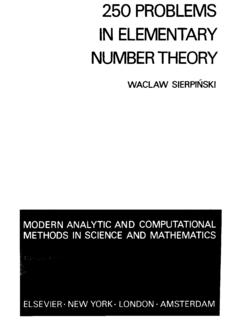Transcription of powered by INTRODUCTION TO CONTROL …
1 Poweredby INTRODUCTION TO CONTROL SYSTEMS IN SCILAB In this Scilab tutorial, we introduce readers to the CONTROL system Toolbox that is available in Scilab/Xcos and known as CACSD. This first tutorial is dedicated to "Linear Time Invariant" (LTI) systems and their representations in Scilab. Level This work is licensed under a Creative Commons Attribution-NonCommercial-NoDerivs Unported License. CONTROL Systems in Scilab page 2/17 Step 1: LTI systems Linear Time Invariant (LTI) systems are a particular class of systems characterized by the following features: Linearity: which means that there is a linear relation between the input and the output of the system . For example, if we scale and sum all the input (linear combination) then the output are scaled and summed in the same manner.
2 More formally, denoting with a generic input and with a generic output we have: Time invariance: which mean that the system is invariant for time translations. Hence, the output produced by the input is identical to the output produced by the input which is shifted by the quantity . Thanks to these properties, in the time domain, we have that any LTI system can be characterized entirely by a single function which is the response to the system s impulse. The system s output is the convolution of the input with the system 's impulse response. In the frequency domain, the system is characterized by the transfer function which is the Laplace transform of the system s impulse response. The same results are true for discrete time linear shift-invariant systems which signals are discrete-time samples.
3 CONTROL Systems in Scilab page 3/17 Step 2: LTI representations LTI systems can be classified into the following two major groups: SISO: Single Input Single Output; MIMO: Multiple Input Multiple Output. LTI systems have several representation forms: Set of differential equations in the state space representation; Transfer function representation; Zero-pole representation. A typical representation of a system with its input and output ports and its internal state Step 3: RLC example This RLC example is used to compare all the LTI representations. The example refers to a RLC low passive filter, where the input is represented by the voltage drop "V_in" while the output "V_out" is voltage across the resistor. In our examples we choose: Input signal: ; Resistor: ; Inductor: ; Capacitor.
4 (Example scheme) CONTROL Systems in Scilab page 4/17 Step 4: Analytical solution of the RLC example The relation between the input and the output of the system is: On the right we report a plot of the solution for the following values of the constants: [V]; [Hz]; [Ohm]; [H]; [F]; with initial conditions: . // Problem data A = ; f = 1e+4; R = 10; // Resistor [Ohm] L = 1e-3; // Inductor [H] C = 1e-6; // Capacitor [F] // Problem function function zdot=RLCsystem(t, y) z1 = y(1); z2 = y(2); // Compute input Vin = A*sin(2*%pi*f*t); zdot(1) = z2; zdot(2) = (Vin - z1 - L*z2/R) /(L*C); endfunction // Simulation time [1 ms] t = linspace(0,1e-3,1001); // Initial conditions and solving the ode system y0 = [0;0]; t0 = t(1); y = ode(y0,t0,t,RLCsystem); // Plotting results Vin = A*sin(2*%pi*f*t)'; scf(1); clf(1); plot(t,[Vin,y(1,:)']); legend(["Vin";"Vout"]).
5 (Numerical solution code) (Simulation results) CONTROL Systems in Scilab page 5/17 Step 5: Xcos diagram of the RLC circuit There can be many Xcos block formulation for the RLC circuit but the one which allows fast and accurate results is the one that uses only integration blocks instead of derivate blocks. The idea is to start assembling the differential part of the diagram as: and and then to complete the scheme taking into consideration the relations (Kirchhoff s laws) and with . At the end, we add the model for as follows: The simulation results are stored in the Scilab mlist variable "results" and plotted using the command // Plotting data plot( , ) (Simulation diagram) (Simulation results) CONTROL Systems in Scilab page 6/17 Step 6: Another Xcos diagram of the RLC circuit On the right we report another Xcos representation of the system which is obtained starting from the system differential equation: As previously done, the scheme is obtained starting from and using the relation which relates the second derivative of the to the other variables.
6 (Simulation diagram) (Simulation results) CONTROL Systems in Scilab page 7/17 Step 7: State space representation The state space representation of any LTI system can be stated as follows: where is the state vector (a collection of all internal variables that are used to describe the dynamic of the system ) of dimension , is the output vector of dimension associated to observation and is the input vector of dimension . Here, the first equation represents the state updating equations while the second one relates the system output to the state variables. In many engineering problem the matrix is the null matrix, and hence the output equation reduces to , which is a weight combination of the state variables.
7 A space-state representation in term of block is reported on the right. Note that the representation requires the choice of the state variable. This choice is not trivial since there are many possibilities. The number of state variables is generally equal to the order of the system s differential equations. In electrical circuit, a typical choice consists of picking all variables associated to differential elements (capacitor and inductor). State space representation Block diagram representation of the state space equations CONTROL Systems in Scilab page 8/17 Step 8: State space representation of the RLC circuit In order to write the space state representation of the RLC circuit we perform the following steps: Choose the modeling variable: Here we use , and ; Write the state update equation in the form ; For the current in the inductor we have: For the voltage across the capacitor we have: Write the observer equation in the form.
8 The output voltage is equal to the voltage of the capacitor . Hence the equation can be written as The diagram representation is reported on the right using the Xcos block: which can directly manage the matrices "A", "B", "C" and "D". (Simulation diagram) (Input mask) (Simulation results) CONTROL Systems in Scilab page 9/17 Step 9: Transfer function representation In a LTI SISO system , a transfer function is a mathematical relation between the input and the output in the Laplace domain considering its initial conditions and equilibrium point to be zero. For example, starting from the differential equation of the RLC example, the transfer function is obtained as follows: that is: In the case of MIMO systems we don t have a single polynomial transfer function but a matrix of transfer functions where each entry is the transfer function relationship between each individual input and each individual output.
9 Examples of Laplace transformations: Time domain Laplace domain CONTROL Systems in Scilab page 10/17 Step 10: Transfer function representation of the RLC circuit The diagram representation is reported on the right. Here we use the Xcos block: which the user can specify the numerator and denominator of the transfer functions in term of the variable "s". The transfer function is and, hence, we have: (Simulation diagram) (Input mask) (Simulation results) CONTROL Systems in Scilab page 11/17 Step 11: Zero-pole representation and example Another possible representation is obtained by the use of the partial fraction decomposition reducing the transfer function into a function of the form: where is the gain constant and and are, respectively, the zeros of the numerator and poles of the denominator of the transfer function.
10 This representation has the advantage to explicit the zeros and poles of the transfer function and so the performance of the dynamic system . If we want to specify the transfer function in term of this representation in Xcos, we can do that using the block and specifying the numerator and denominator. In our case, we have with (Simulation diagram) (Input mask) (Simulation results) CONTROL Systems in Scilab page 12/17 Step 12: Converting between representations In the following steps we will see how to change representation in Scilab in an easy way. Before that, it is necessary to review some notes about polynomial representation in Scilab. A polynomial of degree is a function of the form: Note that in Scilab the order of polynomial coefficient is reversed from that of MATLAB or Octave.









